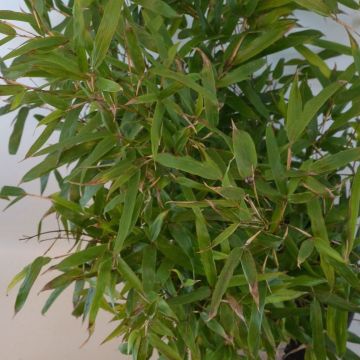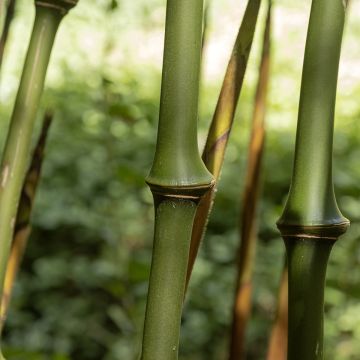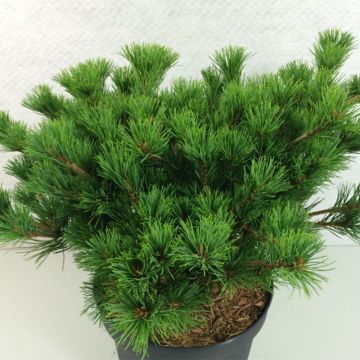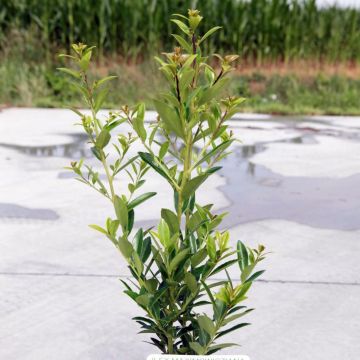

Yellow Bamboo - Phyllostachys aureosulcata Aureocaulis


Yellow Bamboo - Phyllostachys aureosulcata Aureocaulis


Yellow Bamboo - Phyllostachys aureosulcata Aureocaulis


Yellow Bamboo - Phyllostachys aureosulcata Aureocaulis


Yellow Bamboo - Phyllostachys aureosulcata Aureocaulis


Yellow Bamboo - Phyllostachys aureosulcata Aureocaulis
Yellow Bamboo - Phyllostachys aureosulcata Aureocaulis
Phyllostachys aureosulcata Aureocaulis
Golden Groove Bamboo, Yellow Bamboo
The plants are very beautiful, in good health. Arrived well packaged and watered, they are magnificent.
Jean Francois, 20/05/2023
Special offer!
Receive a €20 voucher for any order over €90 (excluding delivery costs, credit notes, and plastic-free options)!
1- Add your favorite plants to your cart.
2- Once you have reached €90, confirm your order (you can even choose the delivery date!).
3- As soon as your order is shipped, you will receive an email containing your voucher code, valid for 3 months (90 days).
Your voucher is unique and can only be used once, for any order with a minimum value of €20, excluding delivery costs.
Can be combined with other current offers, non-divisible and non-refundable.
Home or relay delivery (depending on size and destination)
Schedule delivery date,
and select date in basket
This plant carries a 24 months recovery warranty
More information
We guarantee the quality of our plants for a full growing cycle, and will replace at our expense any plant that fails to recover under normal climatic and planting conditions.
Would this plant suit my garden?
Set up your Plantfit profile →
Description
Phyllostachys aureosulcata 'Aureocaulis', also known as yellow bamboo, is an exceptional variety with particularly bright yellow culms that turn pink or red in the sun, forming a wonderful contrast with its shiny dark green foliage. Spreading and fast-growing, it quickly forms a permanent curtain in the background of a flower bed, a pretty clump in isolation, or a striking composition in a large container on the terrace.
The yellow bamboo belongs to the Poaceae family. It has an elegant, columnar and dense habit. It can reach 6 m to 8 m (20 ft to 26.2 ft) in height at maturity, sometimes even reaching 10 m (33 ft). Its growth is fast and it will reach its maximum size after 5 to 6 years of cultivation. Its shiny evergreen leaves are dark green with a bluish underside, and measure about 15 cm to 17 cm (6.3 in to 6.7 in) in length. The culms sometimes grow in a zigzag pattern at the base. They are bright yellow, sometimes striped with green near the base, and eventually turn pink or light red in the sun. Their diameter reaches 3 cm to 4 cm (1.2 in to 1.6 in). Groves and planting schemes formed of culms of different ages will present a varied but well-coordinated look. This variety is capable of covering an area of 20 square metres in 10 years.
Phyllostachys aureosulcata 'Aureocaulis' is a magnificent bamboo. However, it spreads quickly and broadly so requires a lot of space. It will grow happily in a hedge, in a group or even in a large container as it tolerates pruning very well. This bamboo will provide a beautiful display at the edge of a water feature, in the company of a low-maintained white willow or a Gunnera manicata. However, be careful to channel its rhizomes with a rhizome barrier. The cut stalks make sturdy and elegant stakes. On a terrace, it can be planted with sacred bamboo and banana trees to recreate an exotic atmosphere.
Report an error about the product description
Yellow Bamboo - Phyllostachys aureosulcata Aureocaulis in pictures




Plant habit
Foliage
Botanical data
Phyllostachys
aureosulcata
Aureocaulis
Poaceae
Golden Groove Bamboo, Yellow Bamboo
Cultivar or hybrid
Other Bamboos
View all →Planting and care
Plant Phyllostachys aureosulcata 'Aureocaulis' in late summer and during autumn. Leave a distance of 1m (3.3 ft) to 1.40m (3.3 ft) between each plant when planting in hedges. This bamboo has no special soil type requirements, but it prefers cool, well-drained soil without excessive limestone. It thrives in any exposure. To limit the spread of your Phyllostachys aureosulcata 'Aureocaulis' and prevent it from taking over your entire garden, it is recommended to use a rhizome barrier to define its extension area. Raise the barrier up to 5cm (2 in) above the soil surface. This will prevent excessive rhizome proliferation. In winter, the culms of this bamboo may appear dry and the leaves quickly wither and fall, but it is not dead! New leaves will reappear in March, and new culms will emerge from the soil in summer. For successful establishment, add a mixture of 1/3 garden soil and 2/3 compost to the planting hole. Water during the growing season as bamboo enjoys moisture.
Planting period
Intended location
Care
-
, onOrder confirmed
Reply from on Promesse de fleurs
Similar products
Haven't found what you were looking for?
Hardiness is the lowest winter temperature a plant can endure without suffering serious damage or even dying. However, hardiness is affected by location (a sheltered area, such as a patio), protection (winter cover) and soil type (hardiness is improved by well-drained soil).

Photo Sharing Terms & Conditions
In order to encourage gardeners to interact and share their experiences, Promesse de fleurs offers various media enabling content to be uploaded onto its Site - in particular via the ‘Photo sharing’ module.
The User agrees to refrain from:
- Posting any content that is illegal, prejudicial, insulting, racist, inciteful to hatred, revisionist, contrary to public decency, that infringes on privacy or on the privacy rights of third parties, in particular the publicity rights of persons and goods, intellectual property rights, or the right to privacy.
- Submitting content on behalf of a third party;
- Impersonate the identity of a third party and/or publish any personal information about a third party;
In general, the User undertakes to refrain from any unethical behaviour.
All Content (in particular text, comments, files, images, photos, videos, creative works, etc.), which may be subject to property or intellectual property rights, image or other private rights, shall remain the property of the User, subject to the limited rights granted by the terms of the licence granted by Promesse de fleurs as stated below. Users are at liberty to publish or not to publish such Content on the Site, notably via the ‘Photo Sharing’ facility, and accept that this Content shall be made public and freely accessible, notably on the Internet.
Users further acknowledge, undertake to have ,and guarantee that they hold all necessary rights and permissions to publish such material on the Site, in particular with regard to the legislation in force pertaining to any privacy, property, intellectual property, image, or contractual rights, or rights of any other nature. By publishing such Content on the Site, Users acknowledge accepting full liability as publishers of the Content within the meaning of the law, and grant Promesse de fleurs, free of charge, an inclusive, worldwide licence for the said Content for the entire duration of its publication, including all reproduction, representation, up/downloading, displaying, performing, transmission, and storage rights.
Users also grant permission for their name to be linked to the Content and accept that this link may not always be made available.
By engaging in posting material, Users consent to their Content becoming automatically accessible on the Internet, in particular on other sites and/or blogs and/or web pages of the Promesse de fleurs site, including in particular social pages and the Promesse de fleurs catalogue.
Users may secure the removal of entrusted content free of charge by issuing a simple request via our contact form.
The flowering period indicated on our website applies to countries and regions located in USDA zone 8 (France, the United Kingdom, Ireland, the Netherlands, etc.)
It will vary according to where you live:
- In zones 9 to 10 (Italy, Spain, Greece, etc.), flowering will occur about 2 to 4 weeks earlier.
- In zones 6 to 7 (Germany, Poland, Slovenia, and lower mountainous regions), flowering will be delayed by 2 to 3 weeks.
- In zone 5 (Central Europe, Scandinavia), blooming will be delayed by 3 to 5 weeks.
In temperate climates, pruning of spring-flowering shrubs (forsythia, spireas, etc.) should be done just after flowering.
Pruning of summer-flowering shrubs (Indian Lilac, Perovskia, etc.) can be done in winter or spring.
In cold regions as well as with frost-sensitive plants, avoid pruning too early when severe frosts may still occur.
The planting period indicated on our website applies to countries and regions located in USDA zone 8 (France, United Kingdom, Ireland, Netherlands).
It will vary according to where you live:
- In Mediterranean zones (Marseille, Madrid, Milan, etc.), autumn and winter are the best planting periods.
- In continental zones (Strasbourg, Munich, Vienna, etc.), delay planting by 2 to 3 weeks in spring and bring it forward by 2 to 4 weeks in autumn.
- In mountainous regions (the Alps, Pyrenees, Carpathians, etc.), it is best to plant in late spring (May-June) or late summer (August-September).
The harvesting period indicated on our website applies to countries and regions in USDA zone 8 (France, England, Ireland, the Netherlands).
In colder areas (Scandinavia, Poland, Austria...) fruit and vegetable harvests are likely to be delayed by 3-4 weeks.
In warmer areas (Italy, Spain, Greece, etc.), harvesting will probably take place earlier, depending on weather conditions.
The sowing periods indicated on our website apply to countries and regions within USDA Zone 8 (France, UK, Ireland, Netherlands).
In colder areas (Scandinavia, Poland, Austria...), delay any outdoor sowing by 3-4 weeks, or sow under glass.
In warmer climes (Italy, Spain, Greece, etc.), bring outdoor sowing forward by a few weeks.


















































